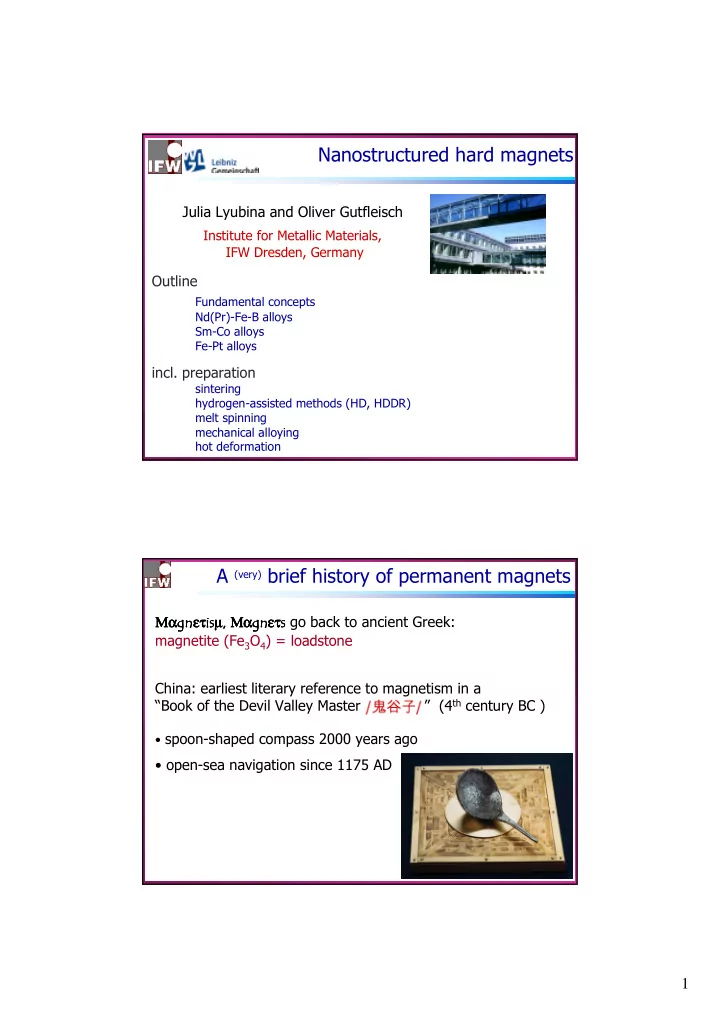

Nanostructured�hard�magnets Julia�Lyubina�and�Oliver�Gutfleisch Institute�for�Metallic�Materials, IFW�Dresden,�Germany Outline Fundamental�concepts Nd(Pr)$Fe$B�alloys Sm$Co�alloys Fe$Pt�alloys incl.�preparation sintering hydrogen$assisted�methods�(HD,�HDDR) melt�spinning mechanical�alloying hot�deformation A� (very) brief�history�of�permanent�magnets Μα �� �� ετ �� �� ετ �� �� �� µ �� µ �� �� �� Μα �� Μα �� �� �� ετ �� ετ � � � � go�back�to�ancient�Greek:� Μα Μα Μα ετ ετ µ µ Μα Μα ετ ετ magnetite�(Fe 3 O 4 )�=�loadstone China:�earliest�literary�reference�to�magnetism�in�a� “Book�of�the�Devil�Valley�Master��������������” (4 th century�BC�) • spoon$shaped�compass�2000�years�ago • open$sea�navigation�since�1175�AD 1
A� (very) brief�history�of�permanent�magnets Print�of�1637 The�first�plant�in�China�manufacturing� magnetic�needles�for�compasses What�is�a�permanent�magnet? Permanent�magnet/hard�magnet – sample�with�a�net�magnetisation�(remanence� J r ) Soft�magnetic�material Hard�magnetic�material J H Classification�based�on�coercivity� H c (how�easily�the�material�can�be�demagnetised) 2
Why�permanent�magnets? • Strong�fields�in�small�volumes • Compact • No�power • No�cooling Materials�for�high�performance�magnets: Nd$Fe$B�(room�temperature�applications) Sm$Co���(high�temp.�up�to� ≈ 350�°C) � brittle � low�corrosion�resistance� The�Walkman�circa�1905 3
Progress�in�the�energy�product� Fe 3 O 4 ferrite Nd$Fe$B Year Intrinsic�magnetic�properties T C� (K) K 1� (MJm $3 ) µ 0 M S� (T) highest�(BH) max Nd 2 Fe 14 B 585 4.9 1.60 SmCo 5 993 17 1.05 highest�operating�temp. high�corrosion�resistance, L1 0 FePt 750 6.6 1.43 mechanical�strength high�temperature�stability, AlNiCo 1133 0.04 1.20 high�corrosion�resistance low�cost�(!), BaFe 12 O 19 720 0.3 0.47 good�chem.�stability,� electrical�resistance� α $Fe 1043 0.05 2.16 4
Extrinsic�magnetic�properties microstructure intrinsic = extrinsic + properties properties 100 µm > D > 1 nm saturation�polarisation� � � remanence� � � anisotropy�field� � � coercivity� � � energy�density� ���� ��� Curie�temperature� � � α -Fe Critical length (nm) Nd 2 Fe 14 B J or B δ w = (A/K 1 ) 1/2 3.9 30 J r or B r D c ~ µ 0 (A/K 1 ) 1/2 /J s 2 214 6 D c : critical single-domain particle size H c δ w : domain wall width δ δ δ δ w δ δ δ H c Critical lengths /�definition nanocrystalline? For�spherical�particles�with�uniaxial� 72 AK = 1 D [ Kittel 1949 ] anisotropy,�the�critical�single$domain� c µ 2 M diameter 0 s The�competition�between�exchange�and� magnetostatic�energy�$ exchange�length A = l (determines�the�grain�size�below�which�the� ex µ 2 M hysteresis�loops�of�multi$phase�magnets�show�a� 0 s single$magnetic$phase�behaviour) The�comparison�between�exchange�and�anisotropy� δ = $ wall$width�parameter A / K w 1 5
Understanding�and�optimising�properties NON$MAGNETIC�PROPs MAGNETIC�PROPs � grain�size�(Km�or�nm) � intrinsic� ↔ extrinsic � texture � coercivity�mechanisms � hot�workability � intergrain coupling � temperature�stability� � magnetic�microstructure � chemical�stability PHASE�CHARACTERISATION PROCESSING � structure�identification � sintering � quantification � melt$spinning � (micro$)�chemistry � mechanical�alloying/milling � metastability � HDDR � transformation � (hot)�deformation � crystallographic relationships Nd$Fe$B�alloys Phase�diagram and�crystal structure Sintered�magnets Anisotropic�bonded�magnets�(HDDR) Hot�deformed�magnets 6
Nd 2 Fe 14 B�phase Crystal�structure Space�group:�P4 2 /mnm 68�atoms�per�unit�cell a�=�8.8�Ǻ;�c�=�12.2 Ǻ c$axis� → easy�magnetisation axis Nd Fe B Nd$Fe$B�phase�diagram�(vertical�sections) [Landgraf 1990] [Schneider�1986] Φ =�Nd 2 Fe 14 B η =�Nd 1.1 Fe 4 B 4 1180�°C Above�685�°C� → liquid�phase� Nd 2 Fe 14 B:�very�narrow�homogeneity�range A�departure�from�the�stoichiometry ⇒ foreign�phases 7
Prototypes�of�R 2 Fe 14 B$based�magnets 1,5 Type III 1,0 Polarisation J ( T ) 0,5 Type I Type II 0,0 -0,5 single-phase exchange-coupled -1,0 R-rich decoupled two-phase exchange-coupled -1,5 -4 -3 -2 -1 0 1 2 3 4 Applied field µ 0 H ( T ) ������ : decoupled�R 2 Fe 14 B grains�separated� H c by�thin�paramagnetic�layer ������� :�exchanged�coupled�grains�based�on� stoichiometric�R 2 Fe 14 B J r �������� : exchanged�coupled�grains�based�on� nanocomposite�R 2 Fe 14 B�/ α $Fe Principal�processing�routes� Magnetically highly anisotropic R-T-phases Coarse-grained powders Isotropic fine-grained powders (J R =J S /2) produced via hydrogen decrepitation + milling produced by: rapid quenching Alignment mechanical alloying intensive/reactive milling in magnetic field HDDR Densification J R > J S /2 by liquid phase sintering NdFeB SmCo highest (BH) max high operat. temp. Hot compaction isotropic, fully dense Remanence enhancement „Anisotropic“ HDDR Hot deformation isotropic exchange-coupled (textured bonded magnets one- or multi-phase structures after pre-alignment) axially/radially textured Highest (BH) max magnets O.�Gutfleisch,�J.�Phys.�D:�Appl.�Phys.� �� (2000)�R157. 8
Sintering� Vacuum - Melting Casting Crushing 5$60� � m particles Milling H�~�10�kOe Aligning H P P Pressing isostatic die$press P P T Sintering/Annealing T� ≈ 1000 ✁ C t Machining/ Surface�treatment adapted from Magnetising H Vacuumschmelze GmbH Sintered�Nd$Fe$B�magnet (BH) max = 451 kJ/m 3 �� ��� �� � � � � η � ���� �� � � � real SEM (BSE� mode) �� � �� �� � (Φ) 10 µ m �������� 5µm Average�grain�size�~�5�mm ������������� ����� ideal �� � �� �� � 1 µ m 200 nm Very�thin�coating�of�2$14$1�grains� 5µm with�Nd$rich�intergranular phase �������� Nd$rich�intergranular phase 9
Sintered�Nd$Fe$B�magnet 1,5 1,0 0,5 polarisation J (T) 0,0 -0,5 (BH) max =�53�MGOe -1,0 -1,5 -4 -2 0 2 4 applied field µ 0 H (T) VACODYM 722HR Microtexture and�domain�structure�of�anisotropic�magnet c-axis ⊥ ⊥ image plane ⊥ ⊥ c-axis II image plane BSE�image 10 µ m 10 µ m Orientation�mapping�and�texture�component Misorientation angle [deg.] Misorientation angle [deg.] Kerr�image 10 µ m 10 µ m 10
Microtexture and�domain�structure�of�isotropic�magnet Backscattered�electron�image Kerr�image 10 µ m 10 µ m Orientation�mapping�and�texture�component Misorientation angle [deg.] Texture�evaluation:�sintered�NdFeB {001} {100} {111} Anisotropic�magnet�with� (BH) max =�56.7�MGOe B r� =�1.52�T Y0 <001> {100} {111} Vacodym 722� 5 commercial�grade�magnet� 10 15 B r� =�1.47�T X0 20 25 30 Isotropic�magnet� B r� =�0.78�T J.�Alloys�and�Comp.�365�(2004)�259 11
Sintering� Vacuum - Melting Casting Crushing by�hydrogen�decrepitation Crushing 5$60� ✂ m particles Milling Aligning H P P Pressing isostatic die$press P P T Sintering/Annealing t Machining/ Surface�treatment adapted from Magnetising H Vacuumschmelze GmbH Hydrogen�decrepitation (HD)�process� Decrepitation → self$pulverisation�of�large�metal particles�into�powder 12
Hydrogen�decrepitation (HD)�process� Crystallographic orientation Intergranular failure 4.5 hydrided powder conventional powder 4.0 grain size FSSS [ µ m] (A) 3.5 3.0 2.5 (I) 0 2 4 6 8 10 12 feed rate [kg/h] Hydrogen decrepitated anisotropic and� Beneficial effect of�HD�process on�feed isotropic sintered NdFeB magnets rate�in�a�jet mill comparing conventional and�hydrided powder Incorporation�of�small�amounts�of�H 2 into�Nd 2 Fe 14 B! Possible�reactions�of�R$T�compounds�with�H 2 amorphous crystalline R n T m H x R n T m H x II I intensity of at�RT Mechanical mechanical activation activation thermo$ R n T m +�H 2 kinetics dynamics temperature hydrogen pressure I���Interstitial absorption II��Amorphisation (HIA)* III III�Disproportionation elevated�T n RH x + m T Gutfleisch�et�al.�1999 Yeh et�al.,�APL�42�(1983)�242 13
Recommend
More recommend